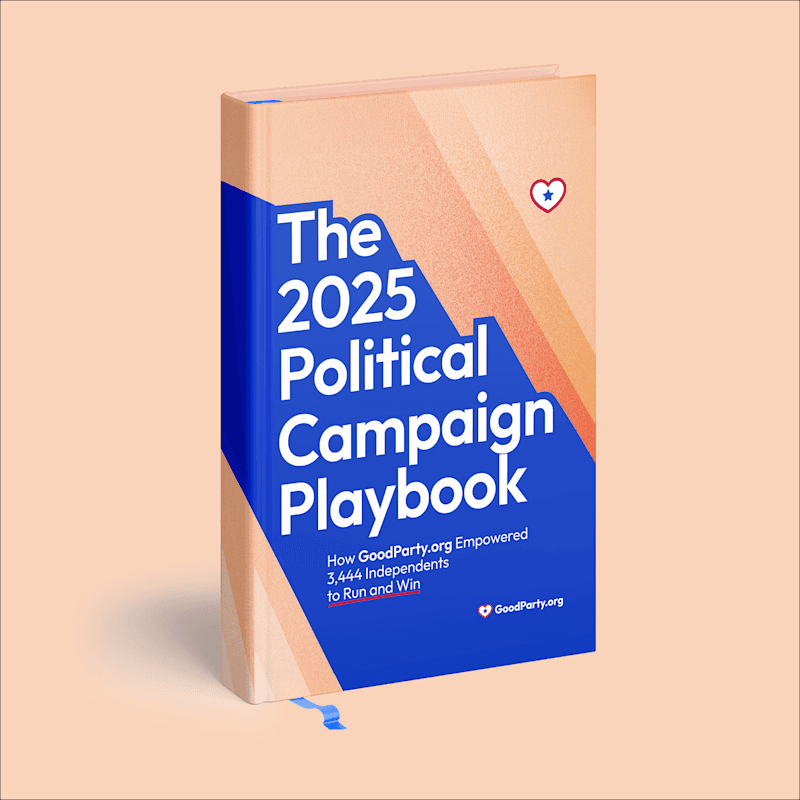
Negative Campaigning: How to Respond to Attack Ads and Smears
If you’ve watched a political ad, scrolled through campaign posts on social media, or tuned into a debate recently, you’ve likely seen more mudslinging than meaningful discussion. Negative campaigning has become a defining feature of American politics, where candidates often spend more time attacking their opponents than talking about solutions.
While negative ads may win headlines and even sway some voters, they come at a cost: lower trust, more apathetic voters, and a political system that feels toxic instead of hopeful.
This guide breaks down what negative campaigning is, why it works, and how candidates can learn from history to fight back with stronger, more positive campaigns.
What Is Negative Campaigning?
Negative campaigning is any political strategy designed to discredit an opponent rather than promote one’s own ideas. It can range from subtle distortions to outright personal attacks.
Common forms of negative campaigning include:
Character Attacks: Highlighting personal flaws, family drama, or unrelated controversies.
Misleading Information: Twisting quotes, editing videos, or spreading falsehoods.
Fear Mongering: Suggesting disastrous consequences if the opponent wins.
Divisive Messaging: Framing issues as “us versus them,” fueling polarization.
Whisper Campaigns: Anonymous rumors spread quietly through private conversations or online networks.
These tactics are powerful because of human psychology. Our brains are wired with negativity bias, meaning we notice and remember bad information more than the good. That’s why even untrue attacks can stick.
The Cost of Negative Campaigning
Negative campaigning doesn’t just hurt candidates. It harms democracy as a whole.
Some of the biggest problems caused by negative campaigning are:
Eroded Trust in Politics: Voters tune out when campaigns feel like smear fests.
Suppressed Turnout: If people believe “all politicians are the same,” many won’t bother to turn out and vote.
Damaged Civil Discourse: Personal attacks replace thoughtful debate about issues.
Driving Away Quality Candidates: Talented community leaders may avoid running for office for fear of being targeted.
In short, negative campaigning may sometimes deliver short-term wins, but it leaves long-term scars on civic life and contributes to an overall loss of faith in democracy.
LEARN MORE: Explore some of the ways an opponent’s negative campaigning can benefit your election.
Negative Campaigning Examples in American Politics
Negative campaigning isn’t new. It’s nearly as old as our country itself. From pamphlets in the 1800s to viral videos in the 2020s, candidates have long used attacks to discredit opponents. These incidents show how attack tactics have shaped elections, sometimes swinging results and sometimes backfiring spectacularly.
Jefferson vs. Adams: The 1800s race between John Adams and Thomas Jefferson is often called the nastiest election in U.S. history. Both camps hurled vicious personal attacks. Adams was branded a monarchist who would crown himself king, while Jefferson was painted as an atheist and a dangerous revolutionary. The bitterness of the campaign led directly to the adoption of the 12th Amendment, which clarified how presidents and vice presidents are elected.
Cleveland vs. Blaine: In 1884, the presidential election of James G. Blaine versus Grover Cleveland was riddled with accusations of corruption. Blaine was plagued by allegations of shady railroad deals, while Cleveland faced scandal over fathering a child out of wedlock. Blaine’s opponents hammered him with the chant: “Blaine, Blaine, James G. Blaine, the continental liar from the state of Maine.” In the end, Cleveland’s strategy of owning up to his personal controversy while highlighting Blaine’s corruption won him the presidency.
Johnson vs. Goldwater: President Lyndon B. Johnson’s 1964 campaign aired the infamous “Daisy” ad, which showed a little girl plucking petals from a flower before cutting to a nuclear explosion. The ad suggested that his competitor, Barry Goldwater, had a hawkish foreign policy that could lead to nuclear war. Though it only aired once, it left an indelible mark on political advertising, demonstrating the power of fear-based messaging.
Bush vs. Dukakis: One of the most notorious attack ads in history, the “Willie Horton” ad in 1988 linked Democratic nominee Michael Dukakis to violent crime by highlighting a Massachusetts prison furlough program that released Horton, who committed assault while on furlough. The ad played heavily on racial fears and undermined Dukakis’s reputation as a leader on law and order. George H.W. Bush went on to win the election decisively, cementing the attack ad as a modern political weapon.
Obama vs. McCain: In 2008, Barack Obama faced attempts to tie him to controversial figures like Reverend Jeremiah Wright and William Ayers. Instead of letting the attacks define him, Obama pivoted to a positive, hopeful message of “Change We Can Believe In.” His campaign organization, rapid responses, and inspiring narrative blunted the smears, showing how a candidate can neutralize negativity by staying disciplined.
Trump vs. DeSantis: In the 2024 Republican primary, a pro-Trump PAC ran the “Pudding Fingers” ad, mocking Ron DeSantis for allegedly eating pudding with his hands and portraying him as greedy and awkward. The attack, though petty, stuck with voters and fed into ridicule at DeSantis’s campaign stops. Already struggling, his candidacy never recovered, proving that even small, meme-like attacks can have outsized impacts in the social media era.
Blake Gendebien vs. Elise Stefanik (NY-21): Democratic challenger Blake Gendebien released an AI-generated video in 2025 mocking Rep. Elise Stefanik’s hesitation to announce a gubernatorial run. The ad featured manipulated visuals of Stefanik singing and dancing, ending with a disclaimer. It drew backlash as “sexist” and misleading, highlighting how AI tools are blurring the line between satire and smear.
Wisconsin Supreme Court Race: Also in 2025, conservative Wisconsin Supreme Court candidate Brad Schimel aired a TV ad featuring a doctored image of his opponent, Susan Crawford. The altered image changed her facial expression to look colder and less approachable. Her campaign argued the ad may violate Wisconsin’s disclosure law on manipulated content, raising new questions about how digital alterations fit into political advertising rules.
Ultimately, negative campaigning can dominate the conversation, but it doesn’t always decide the outcome. Candidates who overcame it, like Cleveland in 1884 or Obama in 2008, did so by pairing rapid response with a compelling, positive vision.
Learning from History: 10 Strategies to Combat Negative Campaigning
The history of American elections proves that mudslinging may win a news cycle, but it rarely builds a movement.
You don’t need to accept toxic campaigning as inevitable. Here are 10 strategies, rooted in real-world lessons, that can help you fight back without sinking to the same level:
#1: Set a Positive Tone Early
Don’t wait for negativity to define your race. Like Barack Obama in 2008, announce your campaign with a hopeful message and keep reinforcing it. A clear, inspiring vision gives voters a reason to tune out attacks and tune in to your solutions.
LEARN MORE: See how to build a winning campaign message to connect with your voters.
#2: Respond Quickly and Factually
When Michael Dukakis ignored the Willie Horton attacks in 1988, the narrative stuck. Contrast that with candidates who rapidly fact-check and clarify misinformation. Build a response team that can issue corrections within hours, not days.
#3: Be Radically Transparent
Accusations of corruption dogged James Blaine in 1884, and his evasive responses cost him the presidency. Candidates today can get ahead of this by openly sharing campaign finances, disavowing shady PAC support, and showing voters they have nothing to hide. Transparency builds credibility that negativity can’t easily shake.
#4: Refocus Debates on Issues, Not Insults
The 1800 election between Jefferson and Adams devolved into personal mudslinging, eroding trust in both. Don’t repeat that mistake. When opponents attack, pivot back to policy: “I hear their critique, but here’s what I’m offering on schools, jobs, or healthcare.” It’s a chance to show leadership and restraint.
#5: Invest in Grassroots Conversations
Face-to-face outreach makes negative ads less powerful. A voter who’s shaken your hand or spoken to you at their door is harder to sway with fear-mongering. Grassroots engagement humanizes your campaign and creates a buffer against smear tactics.
LEARN MORE: Grow your base with our guide to door-to-door canvassing.
#6: Tell Your Own Story
Negative campaigning often works by defining a candidate before they can define themselves. Get ahead of this by sharing authentic personal stories, like why you’re running, what shaped you, and what values guide your decisions. Obama’s “Hope and Change” speech worked because it was rooted in narrative, not just policy.
#7: Use Social Media to Build Trust
In today’s environment, whisper campaigns spread fastest online. Don’t fall into the trap of fighting trolls or amplifying attacks. Instead, use your social media platforms to answer real voter questions, showcase behind-the-scenes authenticity, and correct falsehoods in a calm, professional tone. That balance keeps you above the fray.
#8: Hold Media Accountable
Media outlets play a big role in magnifying attacks, but they can also help debunk smears. Encourage local reporters to fact-check and highlight substantive issues. Build relationships so they come to you for comment rather than running with one-sided attacks.
#9: Stay Relentlessly Focused on Voters
The “Pudding Fingers” ad in 2024 stuck because it was memorable, but it didn’t solve anyone’s problems. Candidates who keep talking about schools, housing, safety, and jobs remind voters of what actually matters. Anchor every aspect of your campaign in real community needs so distractions don’t dominate.
#10: Make and Model a No-Attack Pledge
In an era where doctored images, like those used in Wisconsin’s 2025 Supreme Court race, and AI-generated videos, like the Stefanik ad, are blurring reality, a candidate who publicly pledges not to use deceptive tactics stands out. Invite your opponent to sign on. Even if they refuse, you’ve positioned yourself as the adult in the room.
The most successful leaders, from Cleveland in 1884 to Obama in 2008, neutralized negativity not by ignoring it, but by pairing strong counter-responses with a bigger, more hopeful vision.
LEARN MORE: Having a strong PR plan can help you quickly address and dispel negative campaigning from your opponent.
Building Campaigns Voters Believe In
For local, nonpartisan, and Independent candidates, facing negativity can feel especially isolating. Without the backing of major-party machinery, it’s easy to feel outmatched by attack ads or smear campaigns.
But there’s an opportunity here: candidates who run on authenticity, transparency, and community-driven solutions stand out even more in a toxic political environment. Voters are hungry for campaigns that give them something to believe in, not just something to fear.
That’s exactly why GoodParty.org exists. We provide tools, data, and community support to empower Independent candidates to run positive, effective campaigns that connect with voters on the issues that matter.
Because voters deserve better than fear and smear politics, they deserve candidates and campaigns built on hope, integrity, and solutions.
Photo by Mariah Hewines on Unsplash
Ready to rise above the negativity? Explore GoodParty.org’s campaign tools, built to empower you to launch a campaign voters can believe in.

